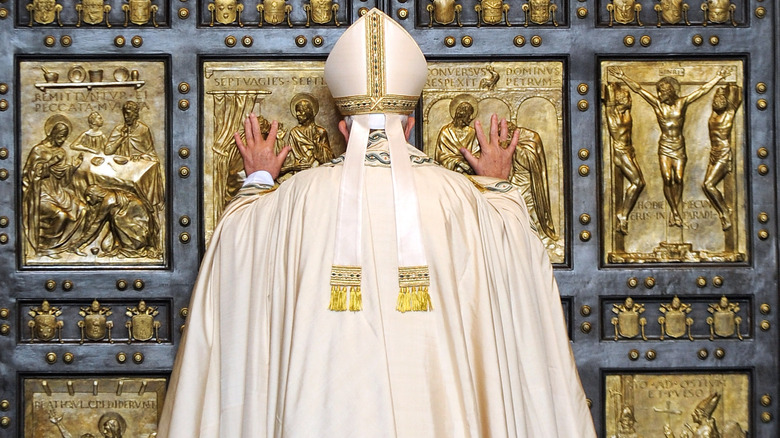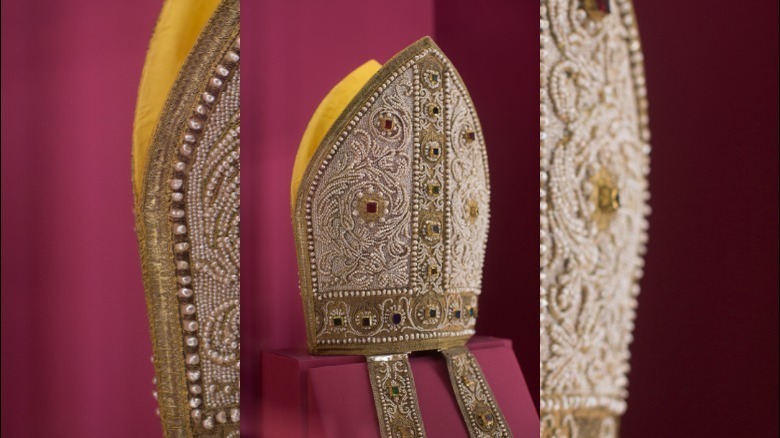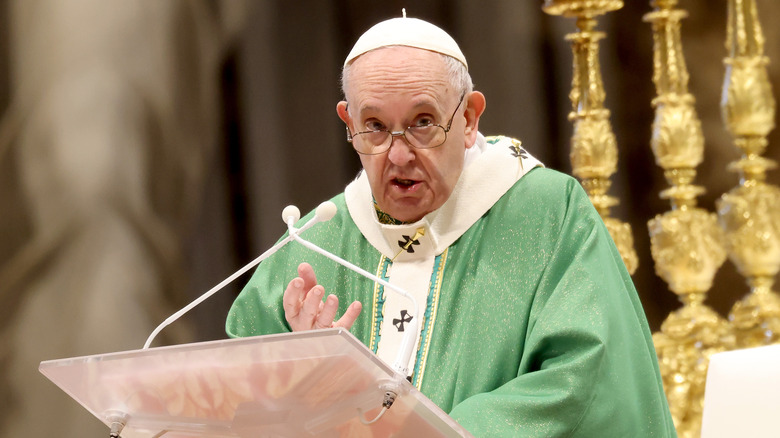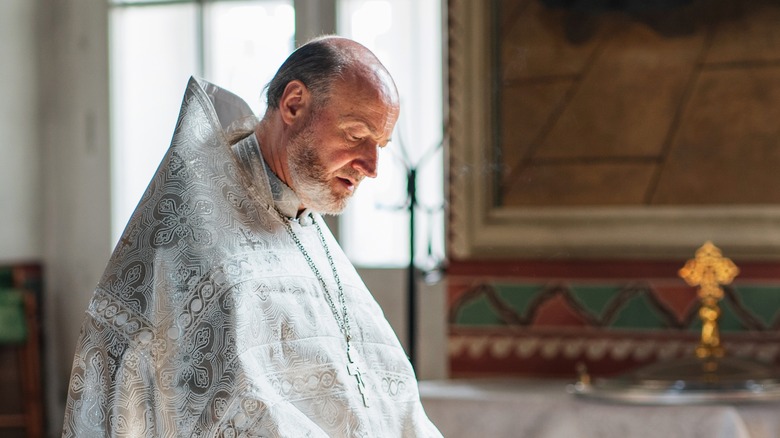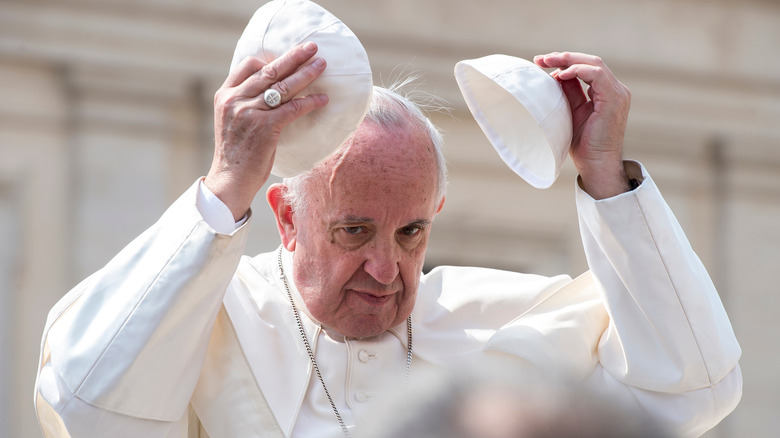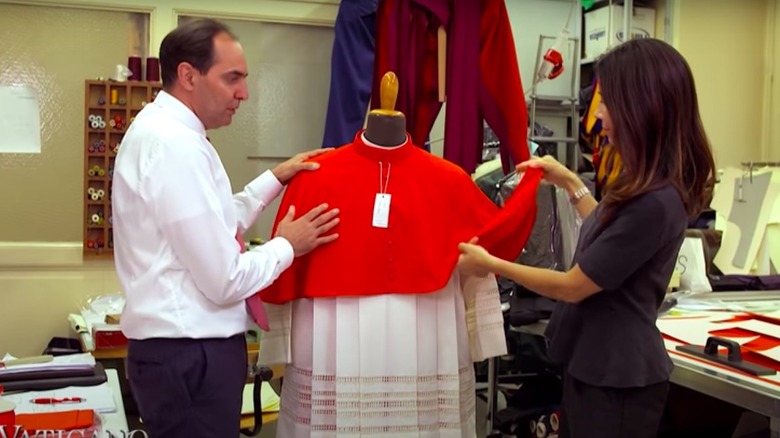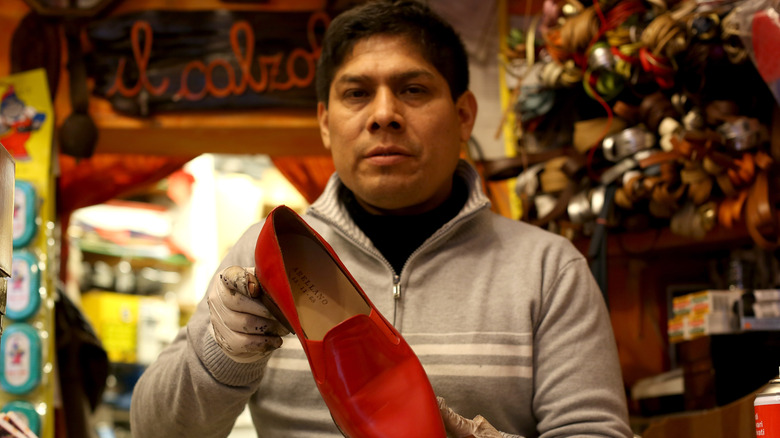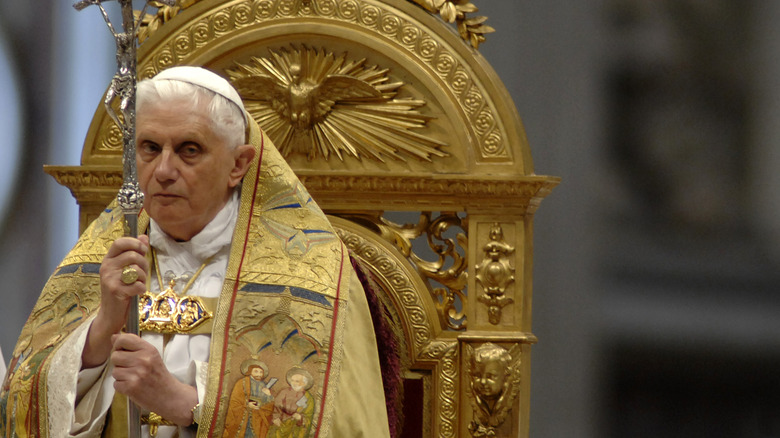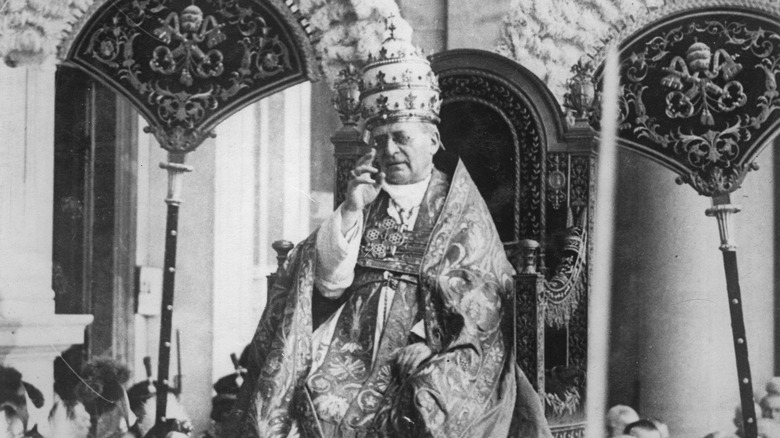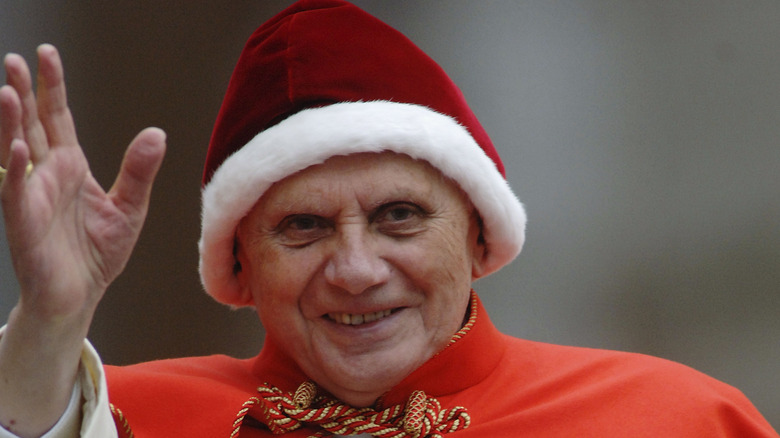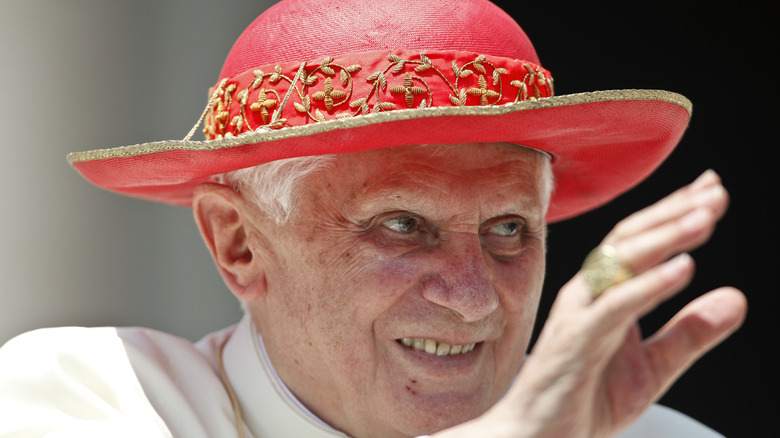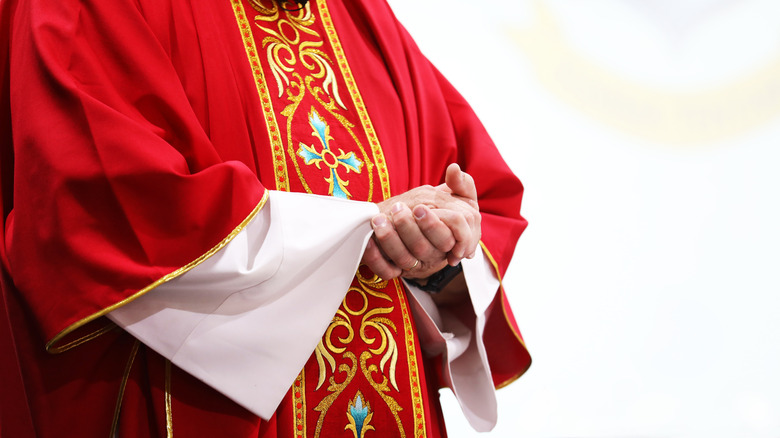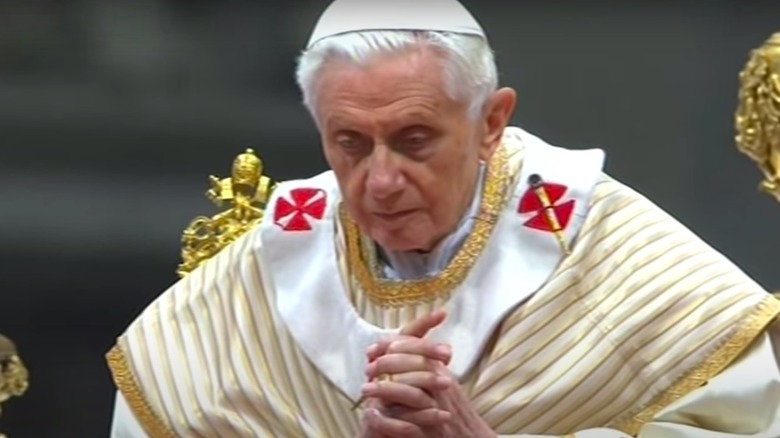The Hidden Meaning Behind The Pope's Clothes
To the 1.2-billion Catholics in the world, the pope is the supreme pontiff, the bishop of Rome, and the head of the Catholic Church. But it's important to remember that the pope is also the head of state for a sovereign territory — the Vatican City State. The pope controlled a significant amount of territory in Italy for more than 1,000 years and had significant influence over other nations and empires (via Britannica). In other words, for a big portion of history, the pope was pretty much an autocrat ruling an empire — and he still dresses the part. Every royal house in history is drenched in symbolism, from colors or clothing only the monarch is permitted to wear to clothing used to convey specific messages. And the pope is no different.
In fact, everything you see the pope wearing has a specific symbolic meaning. There are no accidents when the pope makes a public appearance — from his hat to his shoes, it all means something (and he gets all his clothes from a small shop in Rome that has served the papacy since 1798). Here's the hidden meaning behind the pope's clothes.
The Mitre: The symbol of authority
One of the most recognizable pieces of clothing the pope wears is the mitre, the peaked crown-like hat trimmed in gold. According to Beliefnet, only men holding the rank of bishop or higher can wear the mitre, though it's most commonly associated with the pope. It evolved from the more crown-like papal tiara and dates back to at least the 11th century — though some Catholic scholars believe it can be traced back to the Apostle Peter, the first pope.
The mitre is essentially the symbol of the pope's authority, marking him as the preeminent bishop of the Catholic Church. There are three versions of the mitre — the simplex is plain white and is worn at solemn occasions such as funerals; the auriphrygiata is decorated with gold and is worn during penitential occasions; and the pretiosa is elaborate and decorated with precious stones and is worn on feast days and Sundays.
According to Catholic Answers, the mitre's symbolism is complex. Two lappets (ribbon-like attachments in the back) probably began as a way to stop the mitre from falling to the ground, but today represent the need to follow the spirit and the letter of the bible. The two peaks of the mitre represent the Bible's Old and New Testaments.
The Stole and Pallium: Symbolizing sacrifice
All Catholic priests will be seen wearing a stole, which is a strip of fabric anywhere from 2 to 4 inches wide and about 8 feet long (via Britannica). Stoles are embroidered with Christian symbols, most notably the cross, and can be worn with the ends crossed or left to hang vertically. They can be of different colors that conform with the liturgical color code, but the pope's stole is typically white, and its symbolism is deep. It is often considered a symbol of immortality, and it is also a symbol of the restraints used on Jesus as he was led to his execution, and thus a symbol of the sacrifice and duty that all priests take on (via Beliefnet).
Similar to the stole is the pallium, a sort of collard sash made of lamb's wool with vertical strips hanging in the front and back. According to Britannica, the pallium evolved from an Ancient Greek article of clothing and came to be a special scarf worn by figures of authority as a badge of office. The pope confers a pallium onto bishops and archbishops as a symbol of their unity with him — but bishops can only wear it within their provinces, while the pope can wear it anywhere. The lamb's wool is a symbol of the pope as a shepherd to his flock.
The Cassock: A unique position
The cassock is no longer as widely worn as it once was. As noted by Britannica, the cassock was never a liturgical vestment — it was once the common outfit worn by everyday people in the Roman Empire and then throughout the Middle Ages (it was worn by clergy as well). When fashions changed and the cassock fell out of style, Catholic priests continued to wear it more out of a resistance to change than anything else. In modern times it's not worn as often, but it remains a key part of the pope's wardrobe and is considered his "everyday" uniform, worn when not celebrating religious services.
As noted by Beliefnet, the cassock is still considered something of a "uniform" for Catholic priests, and the pope's use of it symbolizes his unity with the church. Most cassocks are black (higher-ranking priests like cardinals may have colored trim), but the pope's is white to symbolize his authority and uniqueness within the church. U.S. Catholic notes that popes most likely originally wore the fashions of the day, but as their power and prestige increased, their clothing became more aligned with the symbols of authority and power. Per the outlet, the white cassock was established by Pope Innocent V, elected in 1276. A Dominican friar, he continued to wear the white Dominican vestments as pope. His influence was so great that his successors also adopted the white cassock.
The Zuchetto: Color-coding rank
You might call it a skullcap (or a beanie), but the round cap worn by the pope and other Catholic priests is technically called a zucchetto. According to Britannica, the zucchetto evolved from a common form of brimless hat worn by the Romans and has been part of the standard clergy "uniform" since the 1200s.
The zucchetto's practical function is to protect both the pope's head and his hats. The zucchetto is worn under the mitre to protect it, and it's also designed to protect priests who have had their hair cut in a tonsure, a hairstyle that shaves the center of the head as a sign of piety (per The Catholic Spirit). As such, when worn by the pope, it's both a unifying symbol showing him dressed similarly to his priests as well as a sign of his humility.
As noted by Beliefnet, the zucchetto is also color-coded to denote rank within the Catholic Church. Only the pope wears a white zucchetto — cardinals wear scarlet, bishops wear amaranth (a sort of pink-red), and lesser priests wear black. Interestingly, it is tradition that if you offer the pope your own zucchetto, he will trade you his, making this a popular keepsake for those who are lucky enough to gain an audience with the Bishop of Rome.
The Mozzetta: Symbol of Pope's sovereignty
The mozzetta is a curious piece of the pope's traditional uniform. It's essentially a short cape, elbow-length, and is usually worn along with a stole of some sort. The mozzetta is typically worn as part of the pope's choir dress, which is used for public services and when leading the public in prayer. Beliefnet notes that the mozzetta comes in a flexible variety of types: red satin for the summer, red velvet with white fur for the winter, red serge for saying masses for the dead, red clothed for Lent and Advent, and the Paschal mozzetta for Easter.
As noted by TIME, the mozzetta is one of the most symbolic articles of clothing worn by the pope — a sign of their authority and ultimate sovereignty over the church. American Magazine notes that when Pope Benedict abdicated in favor of Pope Francis, one of the visible signs that he'd given up his authority was the absence of the mozzetta. It's such a powerful symbol that when Pope Francis opted not to wear it when he made his first public appearance as pope, it sent shockwaves through the Catholic community. Francis stresses his humility, and his decision to discard the mozzetta is seen to underscore his rejection of earthly power and glory. Nevertheless, many Catholics were disturbed by this symbolic decision.
The Pope's Shoes: Red remnant
If you've seen a pope in public at some point, you may have seen the papal shoes, made of bright red leather that seriously does not go with anything else he is wearing. According to Beliefnet, the red shoes are a holdover from ancient times when red was the most expensive and rarest dye for garments. At one point, only kings and emperors — and popes, who were essentially on the same level of power as monarchs back in the day — were allowed to wear red. In fact, popes used to dress all in red as a symbol of their power. According to Yahoo! News, that changed in the 16th century when Pope Pius V changed the papal vestments from red to white. But the shoes, along with some of the Pope's caps and capes, remained red as remnants of the old days.
As noted by The Washington Post, popes continued to wear the red shoes until John Paul II ascended to the post in 1978. As a sign of humility, John Paul II wore simple brown shoes instead of the flashy red shoes. In 2005, Benedict revived the red shoes and stirred up some controversy as a result. People wondered if the new Pope was a bit too flashy himself — rumors that his shoes were made by the very non-humble brand Prada began to circulate. When Francis took over in 2013, he once again ditched the red shoes, appearing in public wearing simple black shoes.
The Mantum: Symbol of Papal Authority
If you've seen the pope decked out in his full regalia and looking like a medieval emperor, you've seen him wearing the papal mantum — a long and heavy gown-like piece of clothing. It's typically richly decorated with jewels and gold thread and looks extremely uncomfortable. It's similar to another liturgical vestment worn by priests and other clergy called a cope, but it's a little longer.
Only the pope is allowed to wear the mantum. As CNN explains, that's because it's a sign of the pope's authority, a part of the papal regalia. According to CatholicSay, the mantum is placed on the new pope when he is invested with the papal authority (basically a coronation). It was once red in color because the papal color used to be red (popes sometimes still wear a red mantum) but is more commonly white and gold these days. Pope Paul VI stopped wearing the mantum, but Benedict revived the practice during his reign.
According to author Bill Casselman in his book "Word Stash," the word "mantum" is actually made up. Latin does have the word "mantellum," an obscure word meaning a cloak, but Catholic Church leaders thought this sounded like a diminutive — a word that implies smallness ("piglet," for example, is a diminutive for "pig"). So they cut off the last bit and pretended the word "mantum" had always existed.
Triregnum: Literally the Pope's crown
If you need any evidence that the pope was once as much a secular monarch as a spiritual leader, look no further than the triregnum — otherwise known as the papal tiara. As explained by La Stampa, the triregnum is literally a crown with three tiers, and its history dates back to the 9th century, with the second tier added in the late 13th century and the third tier in the 14th century. Author Marco Politi notes in his book "Pope Francis Among the Wolves" that the triregnum represented papal supremacy over all other kings and rulers.
As noted by The Washington Post, popes were presented with the triregnum at their coronations until 1978, when John Paul I declined to wear it. CNN explains that although Pope Paul VI wore the triregnum when he was installed as pope, a few years later, he offered the triregnum up for sale to benefit charity as part of an effort to modernize the papacy and make it more accessible and less imperial. From that point forward, the triregnum was out of style with popes.
According to the Ultimate History Project, since 1978, popes have worn the mitre instead of the triregnum. But the Vatican still has several triregnums, and there's no actual rule stating a pope can't wear it if he wanted to.
The Camauro: A symbol of the old ways
If you've ever seen the pope out and about and thought for a moment you were looking at Santa Claus, you probably saw him wearing a camauro (ABC News notes that it looks a lot like Santa's hat, just without the white pom pom on top — and only the pope is allowed to wear it). According to Catholic Doors Ministry, the camauro is similar to the cap worn by academics in the Middle Ages.
Initially, the camauro didn't have much symbolic meaning. Author Johan van Parys explains in his book "What's the Smoke For?" that it's original purpose was pretty simple: to keep the pope's head warm when he was saying mass in the wintertime. Back in the Middle Ages, after all, heating technology wasn't so great, and those old churches could get mighty drafty. The reason the camauro is bright red is that red was once the papal color, as it traditionally symbolized power.
Pope John XXIII was the last pope to wear the camauro until Pope Benedict appeared in public wearing it. As noted by Father James Martin in The New York Times, the camauro's reappearance — along with several other old-school papal vestments — was taken by many to be a signal from Benedict of a return to a more conservative and traditional approach to the papacy.
The Saturno: More practical than not
When Joseph Ratzinger became Pope Benedict XVI in 2005, he was 78 years old, and no one expected a papal fashion revolution. But as noted by The Guardian, Benedict had a huge influence on the papal style. He brought a lot of old-school papal vestments back and demonstrated a willingness to be impactful with his sartorial choices within the limits of the traditional papal wardrobe.
So when Benedict was spotted wearing a Saturno (also called a Cappello Romano), a wide-brimmed hat that looks suspiciously like a sombrero, it was news (per TIME). Benedict's decision to wear some out-of-fashion papal clothes, like the camauro, was sometimes interpreted as a sign that he was planning to get back to a more traditional approach for the church. While any clergy can wear a saturno, only the pope can wear a red saturno with gold cords, according to Catholic Doors Ministry. As noted by Beliefnet, the papal color was once red because it symbolized power and authority — and Benedict's choice to wear a red saturno could be seen as a nod toward the secular power the pope once wielded.
Still, Catholic News Live notes that there's probably a much simpler and more practical reason why the pope would wear a saturno: its wide brim keeps the sun off his head and rain off his neck. In other words, it basically provides its own shade.
The Chasuble: Color coded charity
The chasuble is a common vestment worn by Catholic clergy. According to Britannica, it's the outermost garment worn by priests at mass. It was once worn by both laypeople and the clergy, but by the 6th century, it had evolved into something worn only as an ecclesiastical vestment.
The pope wears a chasuble when saying mass as well, though there's nothing special about them. But all chasuble are color-coded to abide by the church's liturgical colors. As noted by CNN, the pope will wear a green chasuble at most masses during what's known as "ordinary time." During the seasons of Advent and Lent, the pope will wear a purple chasuble. Twice a year, on Gaudete Sunday (the third Sunday of Advent) and Laetare Sunday (the fourth Sunday of Lent), the pope will wear a rose-colored chasuble. This symbolizes that these seasons are almost ended, and celebration is coming soon. White chasubles are worn during Christmas and other solemnities and feasts, and red are worn on Palm Sunday, Good Friday, and Pentecost Sunday. There are also black and gold chasubles for certain occasions, but they're not as common.
According to author James Monti in his book "A Sense of the Sacred," the chasuble is considered to be symbolic of charity. The idea is that since charity is the greatest of all virtues, the outermost vestment worn by the priest should be representative of that.
The Papal Fanon: Symbolizing continuity
The fanon is an aspect of the papal regalia that flies under the radar unless you're a student of papal fashion. To the untrained eye, it looks like a wide stole or perhaps an oddly-shaped cope of some sort. But as explained by New Advent, the fanon is kind of a deformed circle of fabric with a hole in the middle, and the smaller half of the circle is worn in front. It's striped red and gold and has a small cross embroidered on the front. The piece of clothing is actually an incredibly old part of the papal regalia that dates back to the earliest days of the church. It was originally not restricted to the pope's use — originally, any clergy could wear the fanon — but by the 12th century, it was reserved for the pope.
As noted by the Los Angeles Times, the trend in papal attire had been toward increasing simplicity since the reign of Paul VI in the 1960s. But according to New Liturgical Movement, this trend was reversed when Pope Benedict XVI was enthroned in 2005. Benedict revived many old papal fashions, including the fanon, which was considered significant because the fanon is part of the continuity of the papacy — a visual link to popes going back to the very beginning of the church. As such, Benedict's decision to wear it signifies his desire to return the church to its old traditions, looking backward instead of forward.
